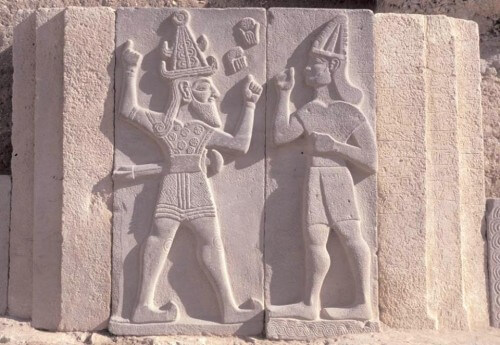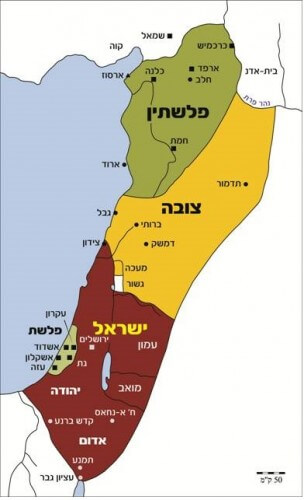Testimonies from southern Turkey and northern Syria, including mention of Tei, King of Palestine, and Hadarezer, King of Tzuba, prove, according to two articles by Prof. Galil, that a united Israelite kingdom did exist

In two new articles published in English in two of the world's leading journals, Prof. Gershon Galil of the Department of Biblical Studies at the University of Haifa, relying on new archaeological and epigraphic findings, outlines the period of David's reign, the alliance he established with the Kingdom of Palestine that resided in the region of Syria, the evidence of contact with Toei Melech Hamath, which is mentioned in the book of Samuel, and the relationship between David's kingdom and the Philistines. "In the ancient Near East in the tenth century, a fierce battle took place between the northern Philistines and the Arameans for the inheritance of the territories that were under the control of the Egyptian and Hittite empires. In this battle, King David of Israel chose to make an alliance with the Philistines, thereby not only stopping the Aramaic expansion into the territories of Israel, but also subduing them and founding a large regional empire that stretched from the Sinai Peninsula to the Euphrates," explained Prof. Galil.
King David, Tei the king of Hamath, Hadadezer the king of Zoba, the Philistines - they all appear in the book of Samuel and are intertwined in the life story of the great Israeli king. In two new studies recently published in two of the leading journals in their field in the world, Ugarit Forschungen and Semitica, Prof. Galil sheds new light on findings that definitely verify the existence in the tenth century BC of a northern Philistine kingdom called "Palestine" and was located in the region of Syria and southern Turkey of Today, and in light of the new findings, he outlines the relationship between David's Kingdom of Israel, Tai's Kingdom of Palestine and the Aramean kingdoms.
In recent years, more and more archaeological and epigraphic evidence has been discovered in Syria and southern Turkey, mainly royal inscriptions engraved on stone tombstones, referring to a kingdom called Palestine that existed in this region. "Today, when there are already eight inscriptions from different sites, it is clear to researchers that such a kingdom existed in the region of Syria and southern Turkey and included cities such as Hamat, Halab and Carchemish. The evidence also shows that this kingdom also included the Sea Gentiles - groups that raided the ancient Middle East in the twelfth century BCE, conquered many areas and settled in them," said Prof. Galil. According to him, the proofs for the existence of the Kingdom of Palestine closed many open ends that researchers had until now. "We know the five cities of the Philistine kingdom from the Bible: Gath Philistim, Ashkelon, Ashdod, Ekron and Gaza, and we also have important archaeological evidence of their existence, but it is not clear when exactly the Philistines arrived in southern Israel, and whether they came from the sea or the land, via Turkey and Syria . In addition, in the inscriptions of Ramses III, king of Egypt (twelfth century BCE), he states that he conquered cities in northern Syria, and took control of an area there that he calls 'the Philistine lands'. However, since there was no evidence of a Philistine settlement in northern Syria in the past, researchers assumed that the Egyptian king simply exaggerated and described places that did not exist. The discovery of the northern kingdom of Palestine helps to understand the Egyptian inscriptions and the reality in northern Syria in those distant days", explains Prof. Galil.

He further added that a number of inscriptions make a direct connection between the archaeological and epigraphic findings in the northern kingdom of Palestine and the Bible: some of them open with the words, "Anchi Tai(ta) the hero, the Palestinian king", "and in the light of philological and historical knowledge it is clear that Tai(ta) is Tai, mentioned in the Bible in the book of Samuel and in the book of Chronicles," he said.
"From the archaeological findings and the inscriptions recently found in the Kingdom of Palestine, we know that at that time there was a tremendous struggle between the Aramaic kingdoms, led by Tzuba, and the North Sea Gentiles, a struggle for territories that had until then been under the control of the fallen Hittite Empire, and the weakened Kingdom of Egypt," says Prof. Galil, adding that the findings They testify that the biblical story about the kingdom of Israel in the days of David is possible, reasonable and logical. "In the Bible we read about an alliance between David and Tei, king of Hamath, against Hadadezer, king of Zoba. We know for sure that Te'i Mahmat existed, that Dadezer Mitzvah existed and that there was a war between them. The biblical evidence in the book of Samuel is therefore firmly anchored in the historical reality of the tenth century," he explains, and emphasizes in particular the text in Samuel XNUMX, XNUMX, XNUMX: "And Tei sent his son Joram to King David to ask him for peace and to bless him for who fought in Hadadezer and they were killed because Hadadezer was a man of the Tei wars."
According to his proposal, Prof. Galil presents the following scenario: the relationship between David and the southern Philistines (especially the people of Gath Philistines) was close at the beginning of his reign in Hebron, however, after the unification of Israel and Judah by David, a war breaks out between the Philistines and David - as described in the Bible . At this stage, the advance of the Arameans led by Hadadezer, king of Zoba, leads to an alliance between David and Tai, king of Hamath, considering "the enemy of my enemy is my friend". The alliance between David and the northern Philistines also leads to an alliance with the southern Philistines, since the Arameans also posed a threat to the Philistines in the land. With joint forces, the Israelis and the Philistines defeat the Arameans and take control of their territory. The close relationship between David and the Philistines is also expressed, according to Prof. Galil, in the fact that during Absalom's rebellion, all the Israelis rebelled against David, and only a few supported him, mainly Philistine warriors (his royal guard, which consisted mainly of Philistines and was called "Khorti and Philistine", as well as It was with me that he came to the aid of David from the Philistines and with him six hundred soldiers). After his great victory over the Arameans, with the help of his allies, David established a large empire from the Sinai Peninsula to the Euphrates (see map).
One of the representatives of the minimalist position regarding the compatibility between the Bible and archeology is the archaeologist Prof. Israel Finkelstein from Tel Aviv University According to their version, Israel during the time of David and Solomon was not united. This position is presented in the book The Beginning of Israel by Prof. Israel Finkelstein and Nir Asher Silverman.

11 תגובות
Kingdom of Palestine? Embarrassing mistake! of the author of the article or of the site? Any attempt to link Palestine with Palestine is simply pathetic
Jesus
Are you coming alone or on the cross? I hope that the wounds on the palm of the hand following the crucifixion have already healed. Say hello to St. Peter.
D.
Open conversation is not good?
Guys, I'll be back tomorrow night!
This site is called "Hidan" for nothing.
Shlomo, Yossi, Nostradamus, Amit, Yair - these are knowledgeable! Each one of them knows, personal information, from personal acquaintance with King David and with the Creator of the world, the only, exclusive truth, which is inexhaustible!
The crisis of psychiatric medicine has not seemed so acute for a long time.
Yossi Shlomo,
Messiah has already come, they called him Jesus, he is already dead, finished.
A very interesting article with one error common to all academic research. David did not unite Judah and Israel. Judah before the time of Rehoboam was not an independent entity at all, but rather a small and not particularly important part of all the clans called Bnei Israel. Only at the time of Rehoboam Jeroboam was the small tribe of Judah separated from all the Israelites.
He takes the conclusions out of context - if there was a united kingdom it would be very different from what is described in the Bible:
Jerusalem could not be the capital of the kingdom in any way because it was an extremely marginal city, if the center of the kingdom was in the north (probably the Hazor area) and the kingdom was of course pagan
There is no connection between the assembly of Arabs in Israel and the Philistines or any other ancient people
The kingdom of the House of David, your Messiah, will soon restore it to its place in our days. Amen!
You will soon make the plant of David your servant grow, and you will contribute its rays in your salvation.